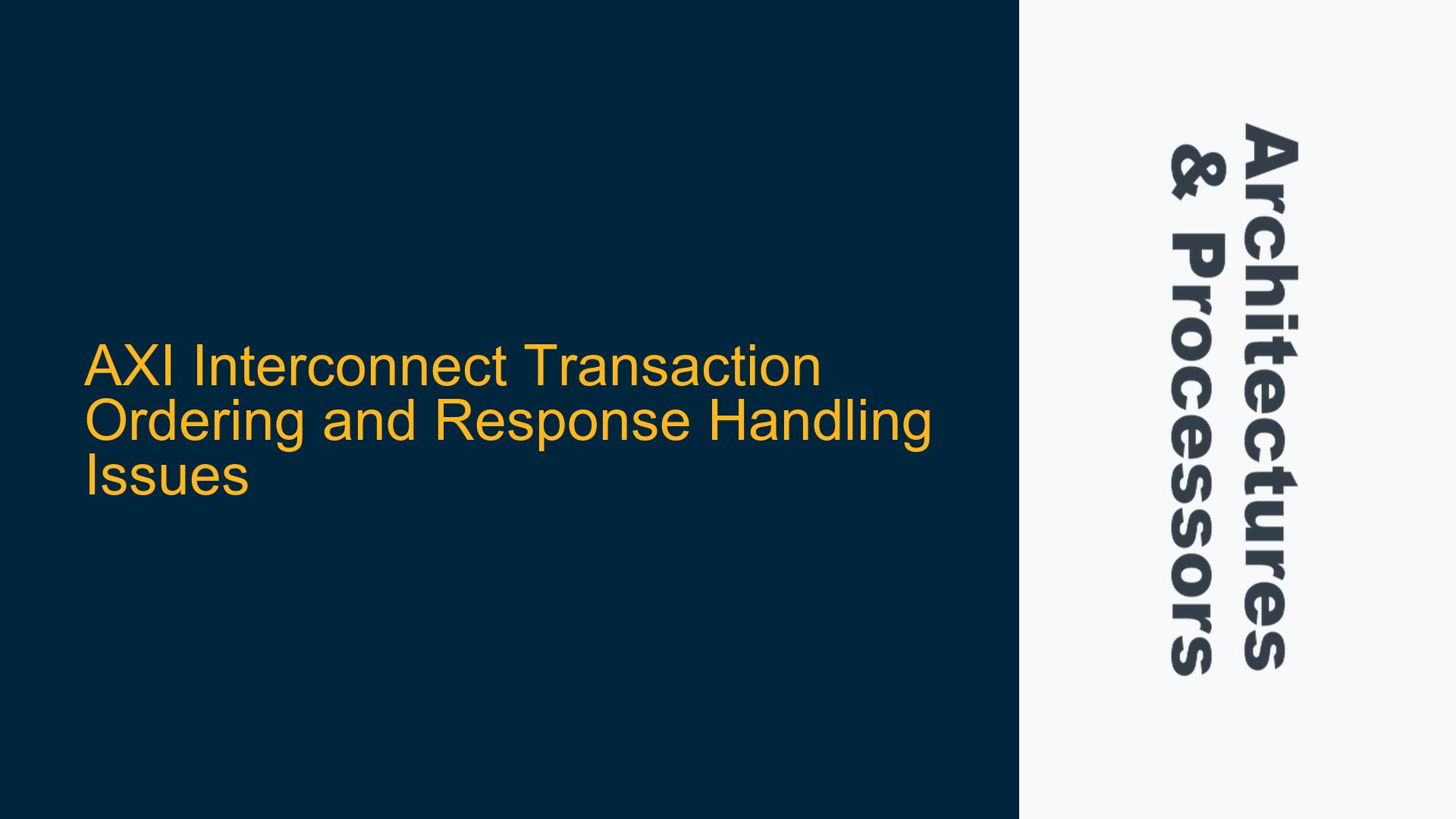AXI Protocol Transaction Ordering Rules and Slave Response Behavior
The Advanced eXtensible Interface (AXI) protocol, widely used in ARM-based systems, defines a set of rules for transaction ordering and response handling. These rules ensure data consistency and predictable behavior in multi-master, multi-slave systems. However, the implementation of these rules, especially in complex interconnects, can lead to subtle issues that are often misunderstood.
In the AXI protocol, transactions are identified by unique IDs. For transactions with the same ID, the protocol mandates that the order of transactions in the same direction (reads or writes) to the same slave must be preserved. This means that if a master issues two write transactions (AA and BB) with the same ID to a single slave, the slave must process AA before BB. However, when these transactions are directed to different slaves through an interconnect, the situation becomes more complex.
The interconnect must ensure that the responses (BRESP) from the slaves are returned to the master in the order the transactions were issued, even if the slaves complete the transactions out of order. This requirement is crucial for maintaining the integrity of the system, especially in scenarios where the master relies on the completion order of transactions for subsequent operations.
The AXI specification (ARM IHI 0022C) states that the order of transactions in the same direction with the same ID to overlapping addresses must be preserved. Overlapping addresses refer to memory regions that are accessed by multiple transactions, where the address ranges of these transactions intersect. This rule ensures that if two transactions with the same ID access overlapping memory regions, they are processed in the order they were issued, preventing data corruption or inconsistency.
Interconnect Implementation and Transaction Reordering Risks
One of the primary causes of transaction ordering issues in AXI-based systems is the improper implementation of the interconnect. The AXI protocol is designed to describe point-to-point connections between a single master and a single slave. When multiple masters and slaves are connected through an interconnect, the interconnect must manage the complexity of routing transactions and ensuring that the protocol rules are adhered to at each interface.
In a typical scenario, a master (MasterA) is connected to an AXI interconnect through a port (PortA). PortA acts as an AXI slave interface to MasterA and an AXI master interface to the interconnect. The interconnect then routes transactions to the appropriate slaves (SlaveA and SlaveB). The interconnect must ensure that the transactions are correctly ordered at both the master and slave interfaces.
However, the interconnect may introduce delays or reorder transactions due to internal buffering, arbitration, or routing logic. For example, if MasterA issues two write transactions (AA and BB) with the same ID to SlaveA and SlaveB, respectively, the interconnect might route BB to SlaveB before AA reaches SlaveA. This reordering can occur if the path to SlaveB has fewer delays or if the interconnect prioritizes certain transactions based on internal logic.
Even if the interconnect routes the transactions out of order, it must ensure that the responses are returned to the master in the correct order. This requires the interconnect to buffer responses and reorder them if necessary. If the interconnect fails to do so, the master may receive responses out of order, leading to incorrect behavior or data corruption.
Another potential cause of transaction ordering issues is the timing of responses from the slaves. If SlaveA takes longer to process AA than SlaveB takes to process BB, SlaveB may return its response before SlaveA. In this case, the interconnect must stall the response from SlaveB until it receives the response from SlaveA, ensuring that the master receives the responses in the correct order.
Ensuring Correct Transaction Ordering and Response Handling
To address transaction ordering and response handling issues in AXI-based systems, several steps can be taken to ensure compliance with the AXI protocol and prevent data corruption or inconsistency.
First, it is essential to carefully design the interconnect to handle transaction ordering correctly. The interconnect must ensure that transactions with the same ID are routed to the appropriate slaves in the correct order and that responses are returned to the master in the order the transactions were issued. This may require implementing buffering and reordering logic within the interconnect to manage delays and ensure compliance with the protocol.
Second, the interconnect must handle overlapping addresses correctly. If two transactions with the same ID access overlapping memory regions, the interconnect must ensure that they are processed in the order they were issued. This may require additional logic to detect overlapping addresses and enforce ordering constraints.
Third, the timing of responses from the slaves must be carefully managed. If a slave takes longer to process a transaction, the interconnect must ensure that the response is not returned to the master until all preceding transactions with the same ID have been completed. This may require implementing stalling logic to delay responses from faster slaves until slower slaves have completed their transactions.
Finally, it is crucial to thoroughly test the system to ensure that transaction ordering and response handling are correctly implemented. This may involve simulating various scenarios, including transactions with the same ID, overlapping addresses, and different response timings, to verify that the system behaves as expected.
In conclusion, transaction ordering and response handling in AXI-based systems can be complex, especially in multi-master, multi-slave configurations. By carefully designing the interconnect, managing overlapping addresses, controlling response timing, and thoroughly testing the system, it is possible to ensure compliance with the AXI protocol and prevent data corruption or inconsistency.






